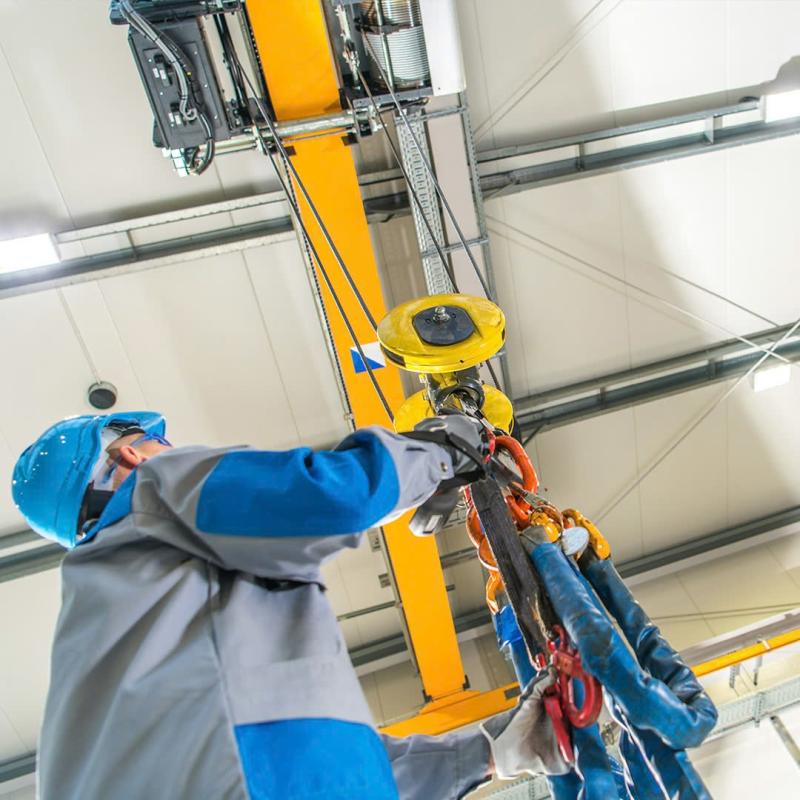



These specifications determine how the crane will integrate with your workspace, the loads it can manage, and how efficiently it supports your material handling operations. Whether you're investing in a freestanding jib crane, wall mounted jib crane, ceiling mounted jib crane, articulating jib crane, or pillar jib crane, getting these sizing factors right is essential for productivity, safety, and operational ROI.
For an overview of all available crane types, explore The resolution of Jib Cranes.
A jib crane is not a one-size-fits-all solution. Choosing the wrong dimensions can result in limited lifting zones, obstruction hazards, or even structural inefficiencies. The right combination of radius, height under boom, and reach allows your team to:
Maximize floor space usage
Avoid workplace congestion
Improve lifting ergonomics
Match crane performance to task complexity
Let’s break down each of these parameters in detail.
The radius (sometimes referred to as boom length or arm length) is the horizontal distance from the crane’s pivot point to the furthest point of load travel.
Freestanding Jib Cranes: 2m to 6m (can rotate 360°)
Wall Mounted Jib Cranes: 2m to 5m (rotation of 180°–200°)
Ceiling Mounted Jib Cranes: Up to 6m depending on beam structure
Articulating Jib Cranes: Variable radius due to segmented boom arms
Pillar Jib Cranes: Similar to freestanding, often up to 5m radius
To evaluate your required radius, measure the distance between the crane’s installation point and the furthest pickup/drop-off location within the work cell.
Learn How to use Jib Cranes efficiently in confined or open-floor facilities.
The height under boom refers to the distance from the ground to the underside of the jib arm. It determines how high the crane can lift and clear over other equipment or structures.
Wall Mounted Jib Cranes: Set at head height for easy access to machines
Pillar Jib Cranes: Provide added vertical clearance for tall items
Ceiling Mounted Jib Cranes: Maximize lift height by eliminating floor obstructions
Ensure the HUB exceeds your load height—including slings and hooks—while maintaining clearance from ceilings, pipes, or lighting.
For structural planning, review An installation to jib cranes.
The reach is the functional area that the crane can cover during operation. It’s a result of radius and rotation range. For instance:
360° rotation with a 5m radius gives a circular 10m-diameter coverage.
180° rotation on a wall mounted unit limits the coverage to a semicircle.
Assess workflow movement—does your operator need to lift from a tool rack and rotate to a machine? Your reach must support that without repositioning.
Client: Fabrication Workshop, Victoria
Product: Wall Mounted Jib Crane – 4m-250
Setup: 4m radius, 180° rotation, HUB 2.8m
Result: Reduced manual handling injuries and cut load transfer time by 30%.
Client: Car Component Manufacturer, Melbourne
Product: Articulated Jib Crane Wall Mounted
Setup: Dual-arm reach, fits around engine bays
Result: Single-operator lifting with precision, improving efficiency in tight spaces.
Pick/Place zone locations
Load sizes and weights
Operator ergonomics
Overhead obstructions
Floor structure and wall integrity
Traffic flow
| Crane Type | Radius (m) | HUB (m) | Rotation | Ideal For |
|---|---|---|---|---|
| Freestanding | 2–6 | 2–4 | 360° | Open floors, centralized zones |
| Wall Mounted | 2–5 | 2–3 | 180–200° | Along walls, fixed machines |
| Ceiling Mounted | 2–6 | Variable | 360° | Overhead use, space saving |
| Articulating | 1–3 | 2–3 | 200°+ | Tight layouts, obstacle avoidance |
| Pillar Jib Crane | 2–5 | 2–4 | 360° | Heavy-duty localized lifting |
Boom Deflection: Long-radius arms may sag under full load—confirm deflection limits with your vendor.
Rotation Stops: Add mechanical stops if rotation beyond a set radius is unsafe.
Load Trolley Width: Factor in trolley size—it affects usable reach slightly.
Compare features with What is the difference between crane and jib cranes.
When specifying a jib crane, getting the dimensions right ensures your investment performs efficiently without future retrofits. Consider not only the radius and HUB but how they interact with your workflow and facility constraints.
Whether you’re building a new warehouse or optimizing an existing workstation, Aardwolf offers a complete suite of jib cranes tailored to every space and task.
See the full lineup at The resolution of Jib Cranes
For project-based consultations or installation, start with How to use Jib Cranes efficiently
Learn more about Optimizing wall-mounted jib cranes
1. How to operate a Jib Cranes safely
3. Over brace jib crane wall mounted
5. Is a Jib Crane a Gantry Crane
6. Articulated Jib Crane Wall Mounted
8. Manual Counterbalance Crane
10. Over Braced Jib Crane Column Mounted
Sign up to receive the latest info on new Aardwolf products, special offers and more.
By signing up you agree to receive emails from Aardwolf with news, special offers, promotions and other information. You can unsubscribe at any time.